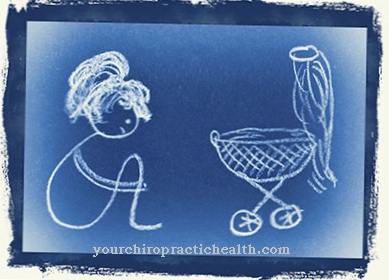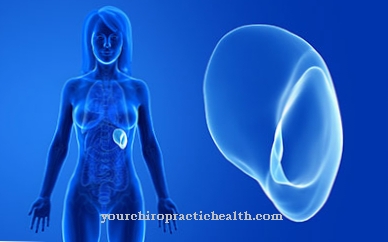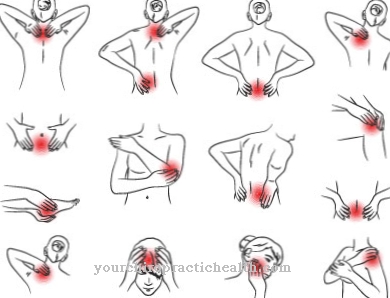The Akathisia, or Unrest, is a symptom from the medical field of neurology. It occurs less by itself, but is primarily known as a side effect of psychopharmaceutical drugs and should therefore always be observed.
What is seat unrest?
.jpg)
© Astrid Gast - stock.adobe.com
As Akathisia Constant motor restlessness of the face, arms and legs under the influence of drugs is called. There is often an inability to sit still or maintain one posture.
Inwardly, an urge for constant movement is felt. Drugs such as neuroleptics, antiemetics and dopamine agonists are known as triggers, but they can also occur as an early symptom of Parkinson's disease.
causes
The causes of the Akathisia are to be found in the motor part of the central nervous system (CNS).This becomes clear only from the fact that it occurs as a symptom or side effect whenever any drug or disease intervenes in the dopaminergic system of the CNS - with neuroleptics this is sometimes desirable and at the same time part of a perhaps excessive main effect, with dopaminergic antiemetics it is clear a side effect, since the suppression of vomiting is achieved via dopamine receptors.
Neuroleptics are psychotropic drugs that have a wide range of uses in neurology and psychiatry and are often used against psychoses, schizoaffective diseases, psychoses of the elderly caused by organ organisms, delusional hallucinations in alcohol withdrawal delirium, severe chronic pain and a variety of other small and large problems of the central nervous system.
Since they are prescribed so often, the side effects are also well known: The so-called extrapyramidal motor symptoms are the so-called "early dyskinesia" with cramping of the facial muscles and movement disorders of the neck and arms. These movements happen involuntarily and come about through shifts in the (among other things) dopamine-transmitter balance of the brain stem. A Parkinon-like syndrome ("Parkinsonoid") can also occur under these circumstances.
Akathisia belongs to this group of early side effects of neuroleptic therapy, which occur relatively frequently, as the mechanism by which it develops is included in the mechanism of action of the drug. They are still relatively harmless and can usually be reversed when the drug is discontinued. What is more feared are the so-called "late dyskinesias", which can occur weeks to months after first taking or even after stopping neuroleptics and are often irreversible.
Antiemetics are active ingredients that are supposed to suppress nausea and vomiting "centrally" in the CNS. For this purpose, some antiemetics also use dopaminergic systems and receptors and are so unspecific that they also influence the motor systems and can trigger dyskinesia and akathisia.
Another possible cause of akathisia, if no medication has been taken, is Parkinson's disease. Restlessness in sitting and moving around can be a symptom, especially in the early stages.
Symptoms, ailments & signs
Sitting unrest manifests itself primarily through the characteristic inner unrest. The affected person feels a strong urge to move and sometimes has the feeling of being electrified. Similar to restless legs syndrome, there is constant trembling of the arms and legs when sitting unrest.
Movement alleviates the symptoms for a short time, but the symptoms reappear relatively quickly afterwards. The long-term urge to move around leads to tension, pain and other muscle ailments. Bad posture, joint diseases, inflammation and cramps cannot be ruled out.
The constant movement can also lead to psychological stress, which in turn increases the sitting restlessness. Sick people are very tense internally and externally and usually feel uncomfortable in their bodies. Symptoms can be permanent or confined to specific situations.
For example, sitting unrest occurs only a few days after taking certain medications in many patients, while in others it is limited to the morning or evening. The discomfort is usually temporary and will go away once the trigger is removed. Long-term consequences or serious complications are not to be expected with well-treated sitting restlessness.
Diagnosis & course
Symptom of Akathisia is the subjectively tormenting motor restlessness that can not be deliberately influenced and that is noticeable on the head and extremities. Akathisia ("inability to sit") got its name from the fact that those affected have to give in to their inner urge to move and are therefore unable to sit still in severe cases. Such a movement only provides relief for a short time, however, so that the unrest persists.
The transitions to other dyskinesia or hyperkinesia ("too much movement") are often fluid. In particular, there is also great similarity to the restless legs syndrome, which mainly affects the legs - here, however, paresthesia in the legs in particular lead to the constant urge to move and there is usually no connection with neuroleptic therapy.
For the diagnosis of akathisia, the medical history is of great importance - if neuroleptics or dopaminergic antiemetics were taken in the previous weeks, sitting and moving rest is a typical side effect. Otherwise, further research needs to be done and looked for other neurological symptoms and diseases. Apparative examinations are out of the question for the side effect akathisia, as the diagnosis can be made purely externally and on the basis of the circumstances.
Complications
Sitting unrest is always associated with an inner tension. Those affected often feel uncomfortable in their bodies and have an increased risk of developing mental illness. However, the urge to move can also lead to physical complications. For example, incorrect posture or tendon and joint inflammation can occur if the same movement is performed over and over again.
Further complaints can occur due to the triggering medication. Neuroleptics are associated with insomnia, concentration problems, loss of libido and other side effects and interactions in addition to sitting restlessness. In the long term, such drugs can cause serious damage to the liver, heart and kidneys. The treatment of sitting restlessness also carries risks.
The beta blockers administered can lead to a sharp drop in blood pressure, dizziness, gastrointestinal complaints, edema and impotence. If the patient has circulatory problems, severe asthma, or low blood pressure, other complications may arise. If you have diabetes mellitus or kidney failure, serious cardiovascular problems can occur. If only the triggering medication is stopped to treat the unsteady sitting position, this can also lead to problems. In addition to withdrawal symptoms, the original symptoms can reappear.
When should you go to the doctor?
Sitting unrest should always be treated by a doctor. In most cases, this complaint is a side effect of various medications, so it should be treated as soon as possible to prevent further complications. Self-healing cannot take place in the case of unrest if the medication is not discontinued or changed. Before changing any medication, however, you should always consult a doctor first.
A doctor should be consulted in the event of seated unrest if the person concerned cannot sit still and usually keeps moving his limbs. This leads to strong tension or even cramps in the muscles of the limbs, which can significantly reduce and restrict the quality of life. Furthermore, a stressed behavior also indicates the unrest and should be examined by a doctor if it occurs over a longer period of time.
In many cases, however, outsiders have to make the person concerned aware of the unrest and persuade them to seek treatment. The unsteady sitting position can be recognized by a GP. Further treatment usually depends on the exact cause and is carried out by a specialist. As a rule, the seated unrest does not reduce the life expectancy of the person concerned.
Treatment & Therapy
The therapy one Akathisia can be done in acute cases with beta blockers, which are able to calm the body overall. If neuroleptic therapy is not required, discontinuation of the offending medication is of course the most effective treatment; otherwise, a reduction in the dose may be considered. A combination with anticholinergic agents can also lead to success.
You can find your medication here
➔ Medicines to calm down and strengthen nervesprevention
In the long term, neuroleptic therapy must be well planned and carefully monitored, since early dyskinesias are comparatively harmless, but later movement disorders can sometimes no longer be reversed with longer therapy. The indication must therefore be made particularly strict.
Aftercare
Since the bacteria that cause trichomycosis palmellina also occur naturally on the skin, follow-up care after a treated trichomycosis palmellina consists in avoiding repopulation or over-colonization of the skin with these bacteria. For this purpose, the hair on previously affected skin areas should be removed regularly.
In addition, a high level of skin hygiene should be observed. This should primarily consist of daily showering with soap. Ideally, an artificially produced soap that cleanses and disinfects the skin is used. Regular hand and skin disinfection can also help prevent the recurrence of trichomycosis palmellina, but this is not absolutely necessary.
Nevertheless, regular disinfection of the hands is recommended if there has ever been trichomycosis palmellina, as this can prevent infection with other bacteria (staphylococcus aureus) that can cause skin diseases. Hands should therefore be thoroughly disinfected, especially after visiting public toilets.
In addition, regular check-ups at the dermatologist can help to detect a renewed skin infection at an early stage. If trichomycosis palmellina recurs despite adherence to high levels of personal hygiene, permanent hair removal using a laser may be necessary. This is especially true for those with excessively high body hair. The benefits and risks of such a removal should be discussed in detail with the attending physician.
You can do that yourself
In addition to the drug treatment with beta blockers, sitting restlessness is treated through various self-help measures. Akathisia patients may need physical therapy. You can support this with exercises at home. However, this only applies to mentally conditioned unrest.
If the symptoms are due to a physical illness such as Parkinson's, this should be treated. Then the patients must primarily orientate themselves towards general measures. This includes taking care of yourself and avoiding stress. In addition, any triggers should be identified and then avoided. An important step that every akathisia patient must take is to keep a complaint diary. Based on the symptoms written down in it, the neurologist can optimize the treatment.
Finally, if you are sitting uneasily, you should use a soft surface. Because patients move around a lot and slide around on their buttocks, inflammation or poor posture can occur. An ergonomically shaped chair is just as important as learning how to sit optimally. It is best for patients to contact an orthopedic surgeon or sports medicine specialist.
In children who suffer from unsteadiness when sitting, the problem often returns on its own if the measures mentioned are followed. If the akathisia has already manifested itself strongly, particular attention should be paid to the correct intake of the prescribed medication.


.jpg)





















.jpg)



